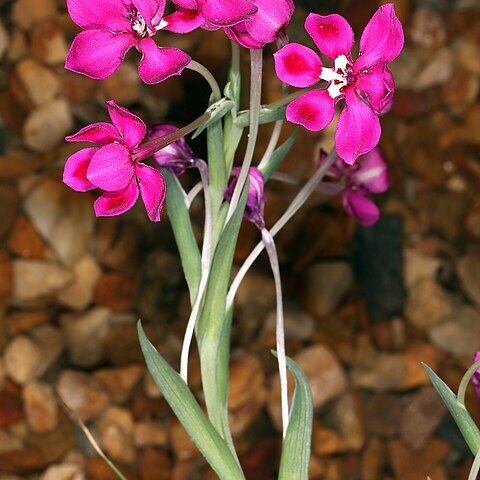Plants 50-150(-200) mm, taller in sheltered or shaded sites, ± acaulescent in exposed sites or in seasons of low rainfall. Corm bell-shaped, 8-10 mm diam.; tunics light brown, basal rim ridged (minutely serrate in plants from Spektakel Mtns). Stem aerial or sometimes ± entirely underground, often branched close to base, compressed, 2-angled, often 2-winged below first flower, wings often minutely serrate. Leaves few, lowermost longer than others, lanceolate to linear, ribbed or corrugate, ± as long or longer than stem, 1.5-5.5 mm wide; remaining leaves shorter and broader, progressively bract-like above. Inflorescence usually a crowded to lax spike, or a head-like cluster at ground level, up to 12-flowered, initially 2-ranked, spiral with age; outer bracts linear to lanceolate, sometimes very broad at base, occasionally ± succulent, outer 15-20 mm long, unifacial for distal 2-4 mm, acute and curving upward, folded or lightly keeled below, keels usually minutely serrate, margins membranous; inner bracts ± 1/2 as long, with broad transparent margins. Flowers zygomorphic, bright cerise to dark magenta (rarely white), lower 3 tepals each with creamy white markings near base, limbs with large central blotch of dark red or purple, scentless; perianth tube cylindric, slender, ± erect, 40-55 mm long, curved outward near apex; tepals subequal, ± broadly obovate, obtuse, limbs concave, 10-12 x ± 5 mm, dorsal erect or sometimes slightly inclined toward stamens, upper lateral tepals reflexed, lower 3 united basally for ± 1 mm, inclined at ± 45° to horizontal. Stamens unilateral, ± erect; filaments 7-8 mm long, exserted ± 4 mm from tube; anthers 3-4 mm long, blue-violet; pollen white or pale blue to mauve. Style erect, dividing close to or just beyond anther tips, ultimately exceeding them; branches 1.0-1.5 mm long, forked for ± 1/2 their length, recurved. Capsules obovoid to oblong, trigonous, 10-15 x 5-7, usually with well-developed wing-like locular ridges in distal half. Seeds globose, light brown, variable in size even on same plant, 1.2-2.2 mm diam.
More
Cormous geophyte, 80-150 mm tall, branching at base, corm tunics brown, margins scalloped. Leaves sword-shaped, ribbed, occasionally lightly hairy. Flowers several in a short to long spike, cherry red with cream and dark red markings on the lower tepals, perianth tube elongate-cylindrical, bracts keeled, curved upward at the tip.

